
Anatole the Robot
.jpg)

A radio controlled French robot made by Jean Dussailly.
According to Tout Savoir magazine for July 1954 Anatole could move its head right and left, move its arms and responded to ten commands; and it weighed 140 kg and was 2m 10cm high.
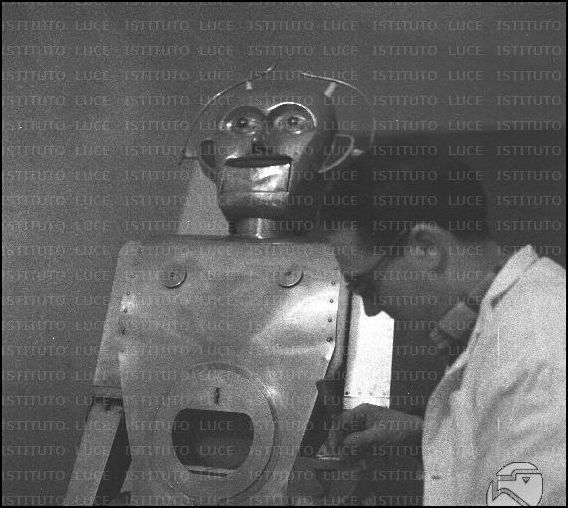
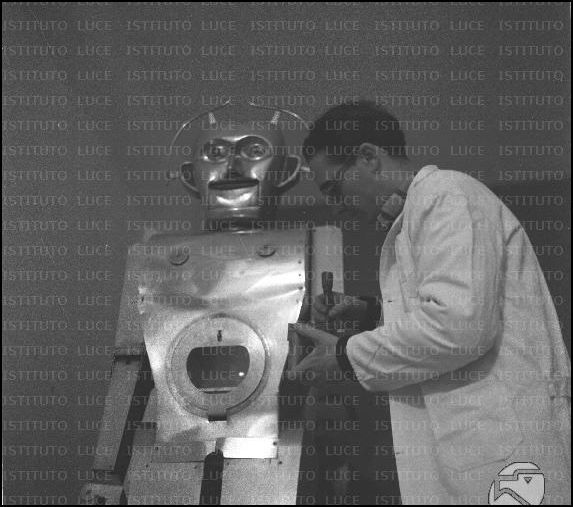

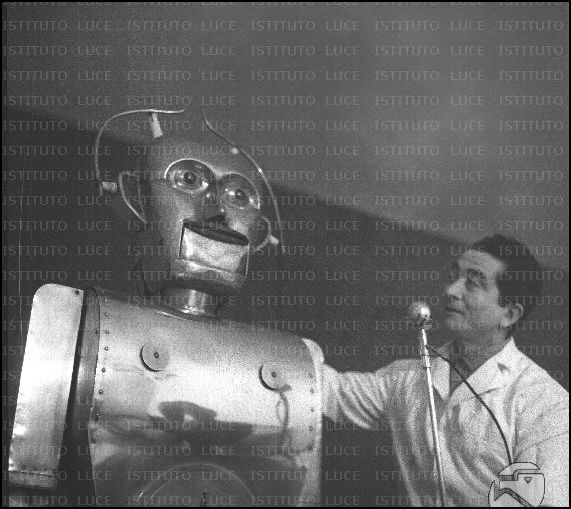
.jpg)
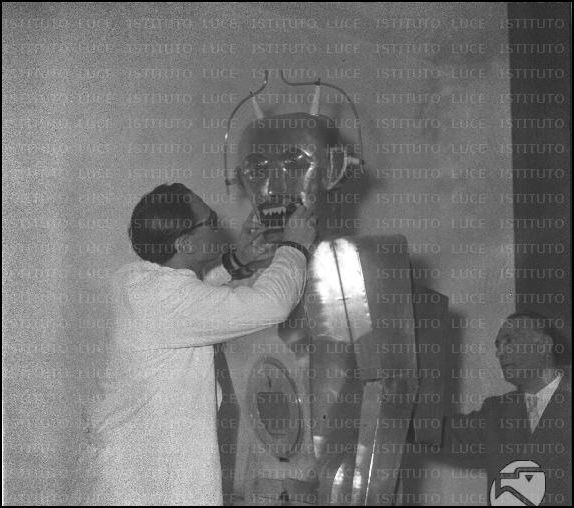

Le Haut-Parleur No. 956 Page 8 , 15 Juin 1954
L’ERE DES ROBOTS EST UNE RÉALITÉ :
Le robot électronique "ANATOLE"
Dans l'esprit du public, il arrive encore souvent que le terme même de « robot » évoque d'instinct la forme d'un être humain. Ce n'est évidemment pas là une forme logique bien que la machine à contrôler le baccalauréat par exemple, se présente sous la forme d'un homme de fer et d'acier.
Il est cependant possible de créer un automate électronique qui rappelle la forme humaine et, c'est ce à quoi s'est applioué Jean Dusailly, qui imagina, jadis, le typophone, appareil épelant les lettres d'un texte imprimé ordinaire pour les aveugles, et a construit « Anatole ».
Le Robot « Anatole »
« Anatole » est un robot télécommandé qui, obéit à son maître, salue à droite et à gauche de la tête, agite les bras et répond à onze signaux-codes différents. Il est capable d'enregistrer un certain nombre d'ordres différents pour les restituer ensuite simultanément. Il est donc, pour cela, doté de mémoire.
Géant de 2 mètres 10 de hauteur et pesant 140 kilogrammes, « Anatole » a une véritable vie de robot. Lors de ses réglages, il lui advint, un jour, d'entrer dans une véritable crise d'épilepsie parce qu'il avait reçu des ordres contradictoires. Lors de la première séance de Pleyel, il souffrit aussi de quelques traumatismes relatifs à son transfert, mais, par contre, à la seconde séance, il fonctionna parfaitement et sut même répondre aux questions posées par le public.
Ce sont les mêmes principes de la radio et de la télécommande, ici associés, qui donnent la parole à ce robot et c'est, bien entendu, par l'intermédiaire d'un émetteur-récepteur, fonctionnant sur des ondes électromagnétiques particulières qu' « Anatole » reçoit les instructions désirables.
English machine translation:
THE ERA OF ROBOTS IS A REALITY:
The electronic robot "ANATOLE"
In the public mind, it still happens frequently that the very term "robot" refers to instinct as a human being. This is obviously not a logical form that the machine to control the degree for example, takes the form of a man of iron and steel.
However, it is possible to create an electronic controller that is reminiscent of the human form and that is what has applioué Jean Dusailly, which came once the typophone, spelling device letters of ordinary printed texts for the blind , and built "Anatole".
The Robot "Anatole"
"Anatole" is a remote controlled robot who obeys his master, welcome to the right and left of the head, waving his arms and responded to eleven different codes signals. It is capable of recording a number of different orders for the return then simultaneously. It is for this, with memory.
A giant at 2 meters 10 centimeters tall and weighing 140 kilograms, "Anatole" is a real life robot. When its settings, it happened one day to enter into a genuine seizure because he had received orders. At the first meeting of Pleyel, he also suffered a few injuries on his transfer, but, again, in the second meeting, it worked perfectly and was able to answer questions raised by the public.
The same principles of radio and the remote, here involved, which give voice to the robot and is, of course, via a transceiver, operating at specific electromagnetic waves that "Anatole" receives instructions desirable.
(Note incorrect spelling: Should be Jean Dussailly, not Jean Dusailly.)
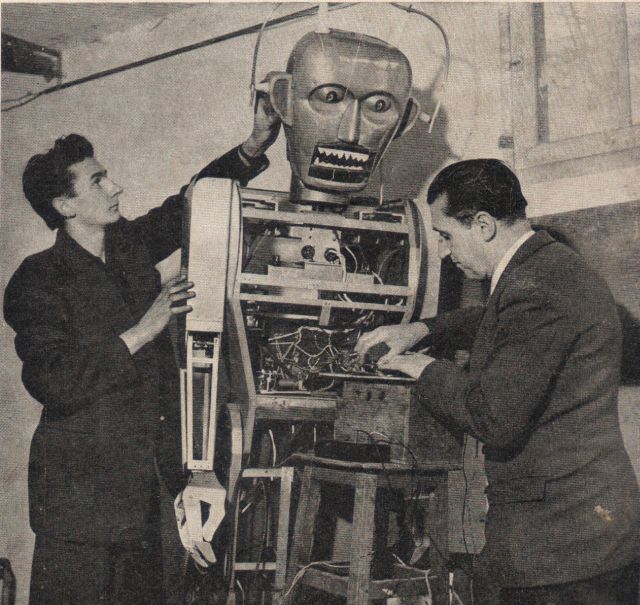
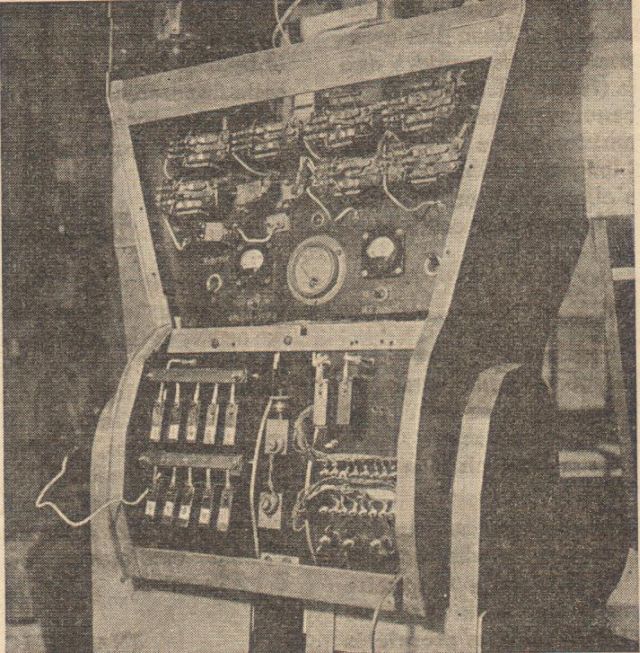
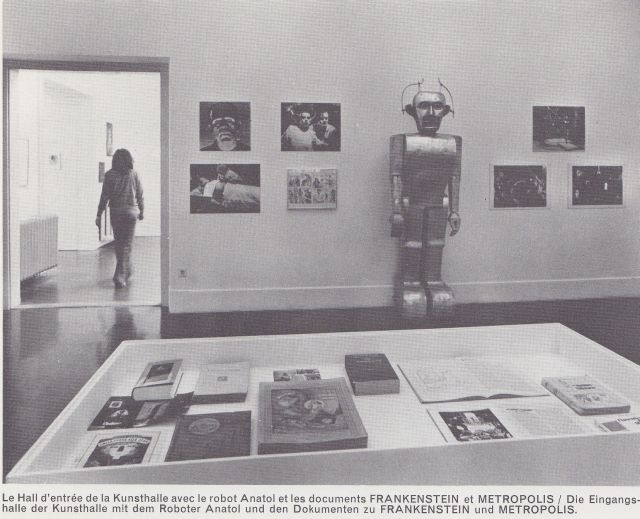
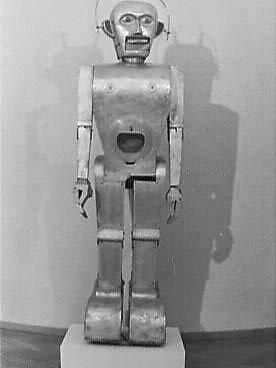
Exhibition "Bachelor Machines" in Amsterdam's Stedelijk Museum (1975); Robot Anatole from collection Fivel

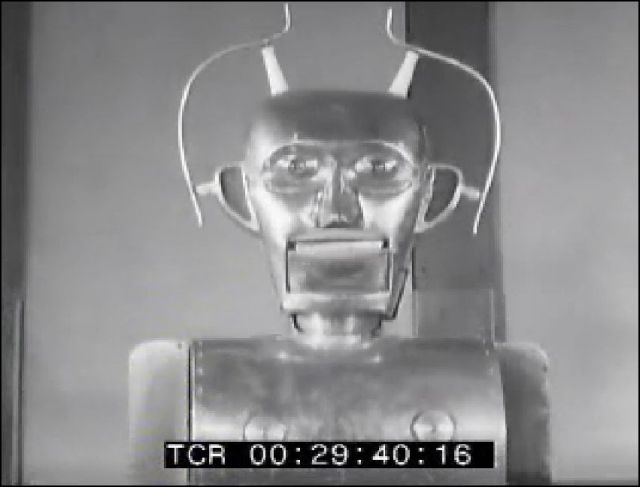
Several stills from a video clip. Three video clips found here, here, and here [the third one not relocated as yet!].
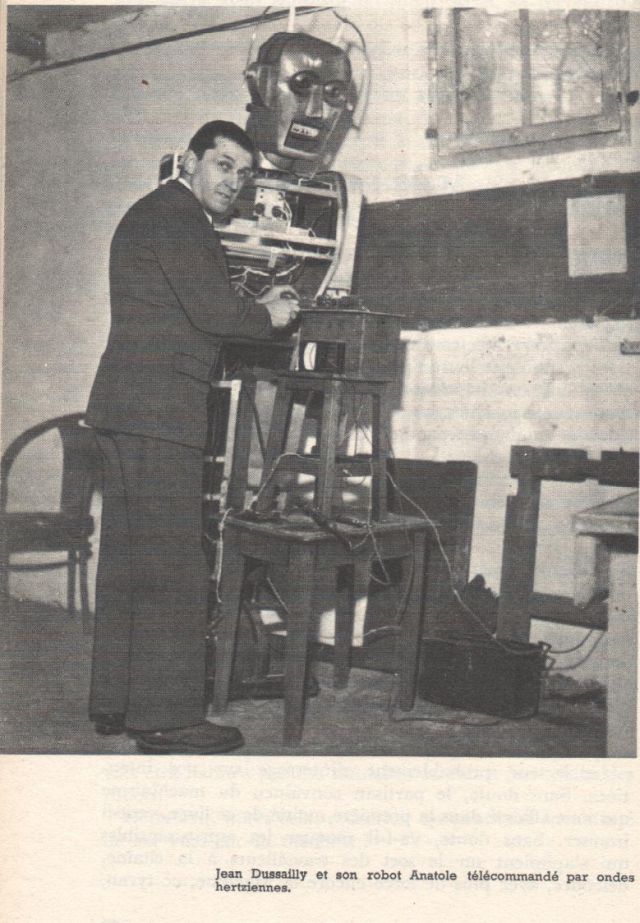

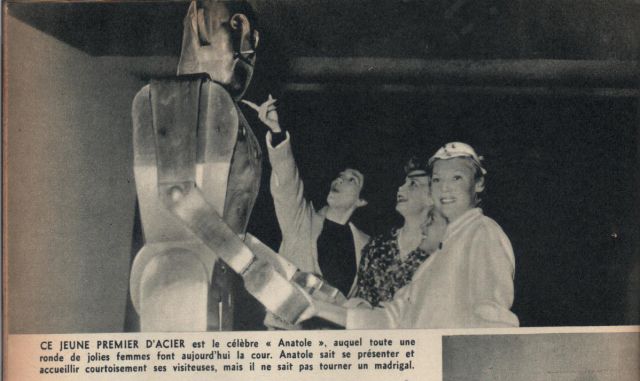
Wired for Action: Thilda Tamar, Argentine-born actress, shakes the hand of Anatole, electronic robot on exhibition in a Paris store. aiting for their turns are from left: Maria Remusat, Arlette Poirier, and Blanchette Bruney, French actresses.
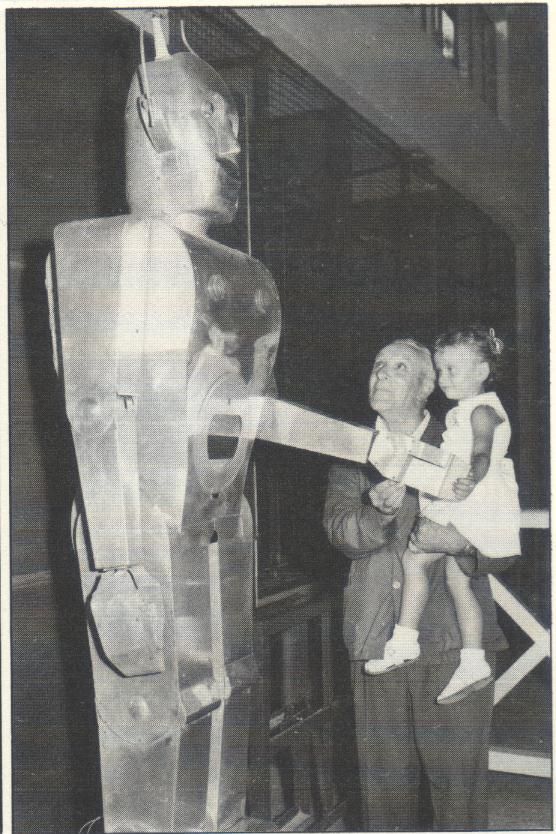
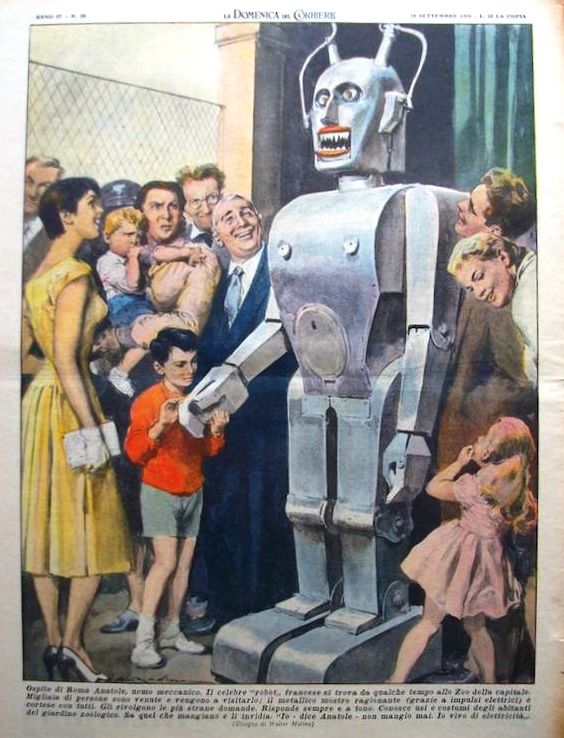
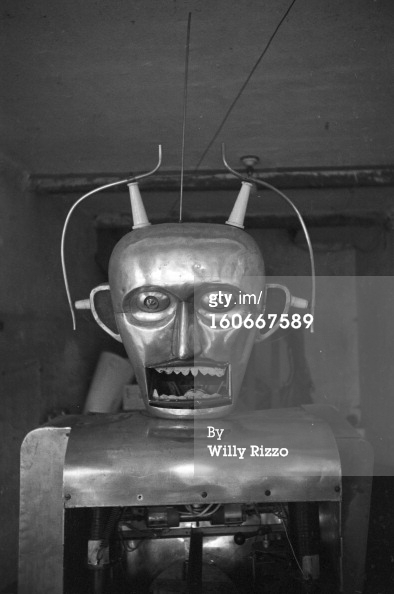
Anatole with Zsa Zsa Gabor at the 24 Hour Le Mans in 1954. Photo by Jack Garofalo via Getty Images..
Source to images and text: here
Published May 21, 2014 by Christine Luce – Google French to English translation
"Coming out of a deep and mysterious cave robot hand to conquer Paris. There is a huge army scout who is about to occupy the capital. Already robots spy crept among the population and the spy. This is not the beginning of a science fiction novel but the first page of a new chapter in the history of humanity is going to live. "To follow the general panorama of the La Semaine du Monde n° 79 14-20 mai 1951 (North France), in the second part: "the great movie" invasion of Paris by robots.
Robots will invade Paris!
Why zoom in on this exciting title that we do not believe a word, either then or now? Just because it's a teaser for striking the sleeping player and excite his curiosity, as he inevitably attracted some of you today, do not deny it! However, after this operation in spicy palate, the paper proves to be a good article by extension, documented and alive. By Jean-Claude Soum, a journalist who published a few books of the same type and was editor of the Monitor International Trade (at least in 1989). Lavishly illustrated with photographs, it relates the encounter with Jean Dessailly , creator of the famous handyman Anatole , the robot that made ​​the covers of magazines and celebrity in his parent garage. Beyond the interview and the description of the model worthy of the best sci-fi, the reporter took the opportunity to make history and scientific development of advanced robotics in 1954 An interesting overview and smart for us too , recalling the imagination and foresight which inflamed the minds at the time, the author makes deductions entirely relevant.
Full article.
"FOLLOW ME, will surprise Anatole in his den. "
The tone of my contact is malicious, but his face remains neutral. It's on the run that leads me to the bottom of the garden. I am in Clamart, a suburb south of Paris, with Jean Dussaillv, electronics engineer. The path we are following rises sharply and drew in a sharp bend.
– Here it is! said Jean Dussailly as we reach some sort of platform.
Anatole is there before us, huge and gleaming at the entrance of a grotto. The newest French robots 2 meters 10 and weighs 100 kg. Her skin shines light alloys with a curious glow in the rays of the setting sun. His green eyes cast a sinister light accentuated by the shadows of the cave. As we approached, he nods his head and opens her arms in a welcoming gesture. All his movements are accompanied by the soft purr of a well-oiled mechanics.
With two small antennas on top of his head, his face grimacing, his clumsy gait caricature that of man, Anatole is the robot as imagined by novelists.
This draws Frankenstein should not deceive us: a robot may not be a kind of artificial man. Some robots have spread to the point that we do not pay more attention. This is the case of the refrigerator. His power is automatically ensured by the electric current and it has a thermostat, forming a contact, decided to start the engine when the temperature rises in the room. Operation did not require any time or supervision or intervention.
That knows how Anatole?
Anticipating my question, the robot alternately raises both arms, turns his head to the left, forward, backward, moves and stops.
– It's not much, says Jean Dussailly drumming on the stomach Anatole. With such a body, how to do better? It is not I who made, I came across the room to scrap a garage. Its builder wanted to animate them with a system of gears and cams very complicated, reminiscent of a clock. It failed because the unit was too heavy. By replacing the mechanical watch my predecessor by tubes and electronic relays, I was able to enable Anatole to perform ten simple steps.
Now armed with a screwdriver, the engineer opens the thorax light alloy robot and thus shows its mechanism. And as he explains how it works, the likeness of a human being with Anatole, who appeared much earlier in its shell in bad taste, and the poverty of his actions, appears Now striking.
Anatole obeys external orders that arrive in the form of electromagnetic pulses. These pulses are emitted by a small remote control station that the engineer and maneuver according to a code established by him. This code is the language that includes the robot. It boils down to a series of points similar to those found in a text in Morse code.
To capture these pulses, Anatole has a sense of perception. Lodged in his forehead, he is in the form of a small receiver unit equipped with subminiature tubes. Thanks to them, he sees the invisible to the human eye, which are immediately transmitted to his brain electromagnetic waves. Here Anatole shows agility of perception well above man. He not only sees waves invisible to us, but the transmission is faster. The waves collected by the receiver propagate along the metal son leading to the brain, to the speed of 300,000 km per second. In humans, this spread is 40 to 60 meters per second. Our five senses through which we perceive the world, are made by millions of sensory cells that respond to a stimulus – light, smell, sound, touch – and convert it into electricity. This electrical impulses, for getting to the brain, following our sensory nerves are worse drivers than current copper wire.
The brain Anatole essentially comprises a selector of the same principle as those used in the automatic telephone. Its role is to interpret the electrical impulses received from the receiver. So he knows that three points mean: lift the left forearm; four points: raise your left arm. This discrimination has been made, it sends orders to interested members in the form of an electric current.
The execution of an order to move a limb consisting of the same process in Anatole than a human being. The muscles in his forearms, arms and neck are powerful electromagnets where son from the brain lead. The flow of electric current emitted by the brain and amplified by the power relay, the magnet attracts or releases his action.
These relays have spectacular uses. Thus, when the Chicago Exhibition of 1933, it was the star Arcturus, which by his time in the sky at 22 pm, opened the heavy bronze doors of the Exhibition. At the appointed, the dim light cast time star was taken by a telescope. A selenium cell transformed this ray of light barely measurable with an ammeter but which relay relay, with each pass taking more power, actionna a dynamo and a motor that twirled the doors!
In the human body, we will find these relays in the form of neurons that significantly amplify the electrical impulses from the brain to the point that by its passage, the muscle fibers shorten or lengthen.
Maneuvering the joystick remote control station, Jean Dussailly just sent Anatole ten orders at a time. No panic, the robot executes, after the particular classification.
– Anatole can accomplish this performance thanks to its electronic memory, the manufacturer explains, pointing to two rows of relays numbered 1 to 10 Briefly, human memory has the function of recording electrical signals from our sensory cells. These relays will have the same task. They collect orders selected by the receiver. Each of them has the memory to perform a specific gesture relay 1 to turn your head to the left, over the 2 turn right. Anatole and stops when its electronic memory warns him not to do anything.
This memory, in the form of ten coils carefully labeled, should not surprise us. Does not it remind indeed hard guarding, carved in wax, our favorite songs, or more simply, the agenda of the businessman who, with a stroke of a pen, erase successive appointments – you during the day?
On the other hand, Anatole has a non-existent sense in the human body: the amnesiac effect, sort of electromagnetic relays for him to forget everything, to have a completely new memory.
Despite its memory, its selector, his eye that sees the invisible, Anatole is disappointing. The scope for action is limited. Certainly he speaks, but here there is a rigging. In his enormous mouth, Jean Dusailly placed an amplifier and all happens as a classical station TSF. Hidden behind a massive shill speaks softly into the microphone of a small transmitter and words collected by a radio lodged in the stomach of the robot, are then distributed by the speaker. Anatole appears to be a robot too rudimentary. His "father" knows. He admits.
– It's DIY ,, course, he constate-. A craft that required four months of work after my day's work, many sleepless nights and a lot of money. Consider an electronic tube small cost 4,000 francs. And I have not received any grant, he added with a mischievous smile.
He leads me into his studio. His son and daughter were there, busy polishing the shoes of Anatole. They are activated, hair in eyes, clutching the rag. We must act quickly, as Anatole must be presented to the public in a few days. Soon the light alloy shell shines like a new penny. Anatole will own the day scheduled for the end (1).
Jean Dusailly contemplates tenderly his two children; then, pushing a chair, he invited me to watch the planes brother Anatole. On the table, on the bench, on the floor, piled up pell-mell tools, relays, vacuum tubes: the arsenal of the robot manufacturer!
(1) " Anatole "must be presented to the public in Paris on May 16 at the Salle Pleyel.
Under the light of a big flood lamp, I contemplate the "father" of Anatole. In his appearance, his house, his manners, his dress, it shows a profound disregard for the trappings of wealth. He wears a blue suit with a brown sweater. His dark tie is knotted loose. It has fifty-seven years; but we can give it to age. It is both young and old, such as enthusiasm and computation. This passion and this measure, I find them in the tone of his voice low and bright. Without movement, he paints a vivid picture of current robots and their future.
– It is a set similar to that of Anatole remote controls that allowed the first crossing of the Atlantic Ocean by an unmanned aircraft. This feat was achieved by an American Skymaster transport plane that traveled the 4,000 miles between the American base Harmonfield English airfield Norton, in 10 hours, without at any time the pilots needed to intervene. The controllers were sealed. The brain of the aircraft remained on the ground and this is the starting point that was flying the aircraft by transmitting radio orders to follow. The brain weighed about half a ton. We are far from 700 grams of the Anatole, indeed, much more rudimentary.
"It's an electronic brain that ENIAC, during the war, allowed the American engineers to build a gun DCA remarkably accurate. ENIAC weighed 30 tons, is 30 meters long and 9 meters wide. With 18,000 vacuum tubes, its 5000 switches with 75 mechanisms addition, it can solve in a split second equation 150 unknowns. His work is that of 250,000 desktop calculators.
"The mechanism of this kind of monsters require any special care. Thus, 12,000 electronic tubes robot SSEC located in a skyscraper of 57 Avenue in New York develop such heat that it took for them to cool, a huge refrigerator capable of producing 52 tons of ice per day .
Faced with such performance, a statement of such figures, I feel uncomfortable with my poor brain of man barely able to multiply two 14-digit numbers in 20 minutes …
Carried away by his subject. Jean Dusailly cites other even more amazing robots.
"Earlier, before the Anatole gross organs before his clumsy, you felt how this robot grimacing was something human. But what about when we see evolve foxes My friend Albert Ducrocq? For Job, the talented electronic fox five senses, Albert Ducrocq built three other small vixens, lighter and faster. When I saw them the last time they came and went through the dining room of their father. With remarkable skill, they avoided the furniture retreated, circumventing the foot of the table, and walked away. At one point, two of them met. Like two beasts, they are mutually observed humées then they turned round by watching. Albert Ducrocq gazed, puzzled. They have complete independence and he could not predict their behavior. Suddenly they left each of his side. At no time did my friend intervened …
"Turtles of the English neurologist Grey Walter, who have more in common with vixens Albert Ducrocq, move freely and have the attributes of life. They hunt and rest as did prehistoric people.
"The game, the food is for them the light. When its batteries are about to be unloaded, Elsie and Elmer (two turtles) goes in search of light. With a photocell that turns on itself, it explores the area. When she spotted a light source, it puts its engines running and goes to her.
"Will it hit a barrier? If it is light, it moved. If it is too heavy, it bypasses. If the light is too bright, frightened, she will hide under furniture. If the light is too low, Elsie turning around, desperate. When at last she found what suited him, she approaches as close to the base of the bulb which is provided with an outlet specially equipped to provide its battery power from the mains. Once sated, she will sleep quietly in a dark corner.
"We are in awe of such electronic wonders. But our wonder becomes deep concern at the homeostat amazing English psychiatrist, Walter Ross Ashby. This also wonderful incomprehensible machine consists of four small vessels packed with vacuum tubes, relays and pallets. It has nothing in common with the electronic brains. It is neither calculations nor solves math problems. His goal is to find a balance between many competing stimuli position.
"In biology, we mean by the term homeostasis faculty that has a living organism to maintain relatively constant a state of equilibrium. That's what makes the Ashby homeostat.
"However, the English scientist is working in a thousand ways to Traver operation. So he hands her traps, playing tricks on him by disconnecting one or two elements, paralyzing one or more pallets, limiting their movements by obstacles, by switching the poles of the current. Despite all these obstacles, the homeostat always an internal organization that responds to the new situation. It achieves this balance after a few minutes or a few hours of trial and error. It uses impetuous or slow movements, he is methodically and in a disorderly manner. It depends on his mood, said Ashby, but still it served its purpose. It is a model of animal adaptation to the environment.
"If today homeostat is useless, tomorrow he will rule us. There is a balance between different and independent of each other excitations. But what will happen if he. in the near future, the English scientist, after some modifications, it poses real problems? Well! he will find the solution.
"Thus, it is conceivable, and this is not an anticipation of a novelist driven by an overactive imagination, that when a government wants to fix the price of butter or iron. it will appeal to a machine of the type homeostat Ashby. To determine the price of a commodity, we must take into account a multitude of factors: cost, volume of production, consumer buying opportunity. desires of producers, requirements for political parties. No human mind can overcome this problem. For cons, the machine will receive all the factors, will assimilate and always give an equilibrium price.
"In his book" Design for a Brain, "" A project for a brain, "Ashby goes further and writes:" Such a machine will be driven by statistical tables enormous, with volumes of scientific facts, so that after a certain time, it will give a huge amount of scrambled instructions, taking into account all relevant factors. These instructions appear incomprehensible, but the men who will closely follow the problems be solved gradually. "
A kind of reverie suddenly interrupted Jean Dusailly. He lights a cigarette, hands me the fire.
– Do you know that Anatole was taken a day of madness? As usual, I ordered it by remote control from a few movements. He executed perfectly first, then suddenly. He was carrying a terrible chill. He threw his arms in all directions. In seeing him gesticulate. I thought of a man caught a seizure. Finally, armed with pliers, I managed to cut a cable connection in the brain. Immediately. Anatole regained his composure. My gesture, cutting the cable, was similar to the surgeon performing the lobotomy, which involves removing a diseased brain cells. whose connections disturbed cause severe mental disorders.
"The ultra-sensitive electronic devices grow their resemblance to the human brain to be suffering from serious neuroses. After a long labor, they suffer from nervous shocks and morning beginning their work they are so sleepy that we must get them out of their torpor by a series of free exercises like sudden current paths followed many cuts .
"Robert Seeber. expert at IBM. A major global companies specialized in building electronic brains, which reports these facts, says that when a robot is suffering from early blues, expresses his aversion to work by calculating slowly. Although the operator has plugged the current, the tubes light up and the desired temperature is reached, the device does not work. Only after half an hour of testing it finally agrees to calculate correctly. This laziness, often men know it, in the form of cockroach morning.
"At a recent scientific conference held in New York, Dr. Sharmon, American Telephone Company, reported the strange behavior of a telephone distributor of a central Manhattan. Throughout the duration of the war and the three years that followed, they worked perfectly. Then his behavior became strange and began to perform similar acts as those being done by a man with schizophrenia. A team of engineers then worked to discover what was the organ involved. But in vain. In the center, the work gradually diminished. The distributor working much less recovered from his troubles and now it is completely healed. His illness was of a functional nature. He had suffered as overworked people. a nervous collapse. He needed to leave and rest cure gave it up completely.
Rummaging through the file in front of him, Jean Dusailly pushes a pink paper in front of me.
– Here is the brother Anatole, he said.
I look: features and figures intertwine in an incomprehensible way. Jean Dusailly explains:
"In fact, the brother Anatole keep the same shell. But it will have all the directions as may be necessary: ​​eyes (photocells), radar, ultrasonic sensors, ultraviolet, infrared. It may, for example. detect human presence, even in the dark. He will have his mood swings. And in response to a shove, he can laugh if it is in a good mood … or flank a solid punch in the ribs of the joker! He will play for the ladies …
He forgot my presence. He dreams. In his corner, it seemed Anatole issued a confident growl.
Jean-Claude SOUM
For those readers who wish to complete their documentation on robots and electronic brains we advise them the following books: "Brains soulless", "Robots", Rolf Strehl (Self edict.) "Rise of the Robots", Albert Ducrocq (edict. Julliard). "The Artificial Mind" Pierre de Latil (edict. Gallimard).
1947
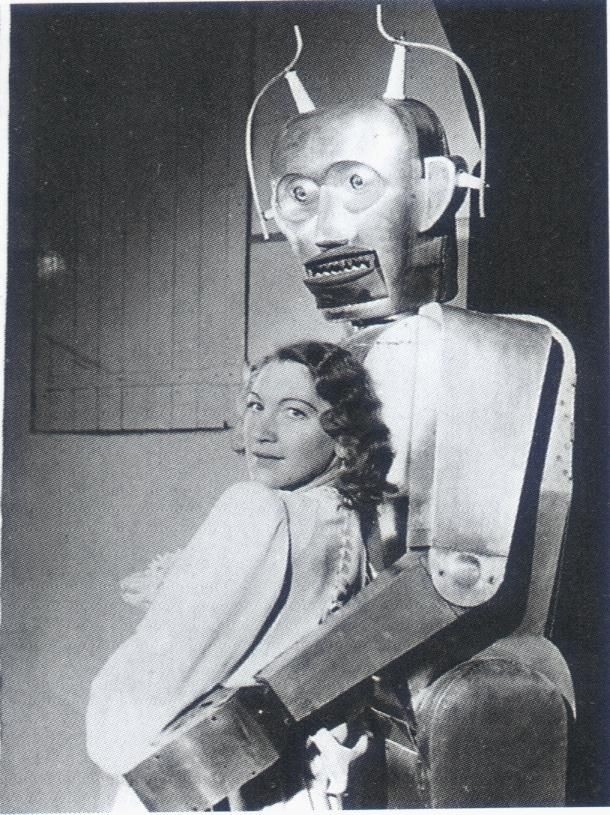
The French actress Mag Villars with the robot called "Marsulus" the Martian that they both appeared in a French production.
The earliest copy of this image came out in the magazine Tiempo – Volume 12 – Page 44, in 1947.

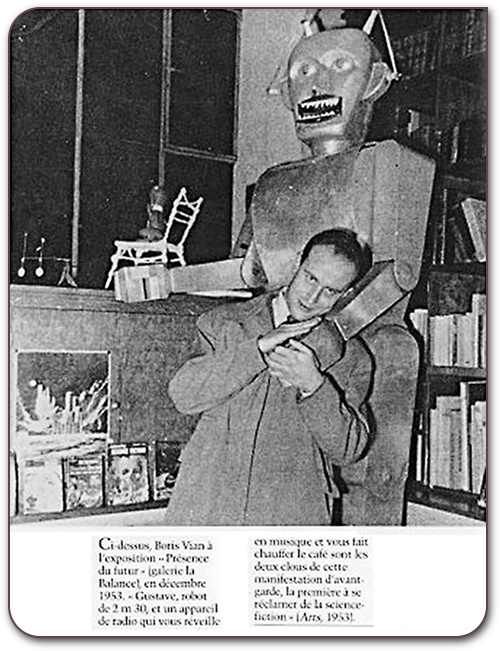
Boris Vian with "Gustave" at the Science and Fiction Exposition in France, December 1953.
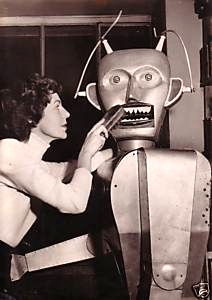
From a recently discovered article above, it appears that "Anatole" was originally "Gustave", thought to be of Russian origin.
Dussailly is said to have bought the robot from a garage which had, in turn, bought it at the end of the Library's Exposition on Science Fiction in late 1953, and refurbished it. However, from the picture below, we see that a French inventor by the name of M. Koralek, a noted engineer, was most likely the original inventor of "Gustave".
So he is of French origin, not Russian.
Excerpt from French article found here.
Comme je ne suis pas collectionneur et que le plaisir de vivre m'intéresse plus que la possession, je fus amené, un jour de dèche absolue, à vendre cet ensemble rare à Valérie Schmidt ? — dont la librairie voisinait celle du Minotaure, spécialisée dans le cinéma, que je fréquentais assidûment. J'avais appris qu'elle y préparait une exposition sur la Science-Fiction ancienne et moderne. Afin d'augmenter le fonds avant la transformation, puis l'exposition inaugurale de la Balance en librairie de Science-Fiction, la première en France, je lui portai pendant une semaine mes livres dans une large valise en carton. Je contribuai aussi à l'exposition grâce à une singulière trouvaille. Sillonnant Paris et sa banlieue en solex chez les libraires, les brocanteurs, les chiffonniers, les ferrailleurs, d'abord pour l'agrément, aussi pour ramasser, découvrir d'autres livres destinés à augmenter le fonds ancien de la librairie, je tombai par hasard, à Montreuil, sur un robot en fonte d'aluminium issu tout droit de Métropolis, d'origine russe il me semble bien. Son achat fut négocié et le monstre de métal qui faisait plus de deux mètres de hauteur, baptisé Gustave, fut installé en vedette dans la librairie. Totem signifiant, il attira tous les regards. À la fin de l'exposition, ce robot fut revendu à un garagiste, puis redécouvert par un certain Jean Dussailly qui le perfectionna ?, remplaçant son système de rouages et de cames par des tubes et des relais électroniques.
English Google Translation
As I am not a collector and the enjoyment of life interests me more than the possession, I was brought a day of absolute dèche to sell this rare set ? Valerie Schmidt – whose bookstore that neighbored the Minotaur, specializing in film, I attended regularly. I learned that she was preparing an exhibition on science fiction, ancient and modern. To increase the funds before the transformation, then the inaugural exhibition of the Balance in library Science Fiction, the first in France, I gave him my books for a week in a large cardboard suitcase. I helped as exposure through a unique find. Plying Paris and its suburbs solex among booksellers, antique shops, ragpickers, the wreckers, first for approval, also to collect, discover other books intended to increase the funds of the former bookstore, I stumbled by chance, Montreuil, a robot from cast aluminum straight Metropolis of Russian origin it seems to me. Its purchase was negotiated and the metal monster that was more than two meters high, called Gustave was installed featured in the library. Totem meaning, he drew all eyes. At the end of the exhibition, the robot was sold to a garage, and then rediscovered by a certain Jean Dussailly who perfected ?, replacing its system of gears and cams tubes and electronic relays.
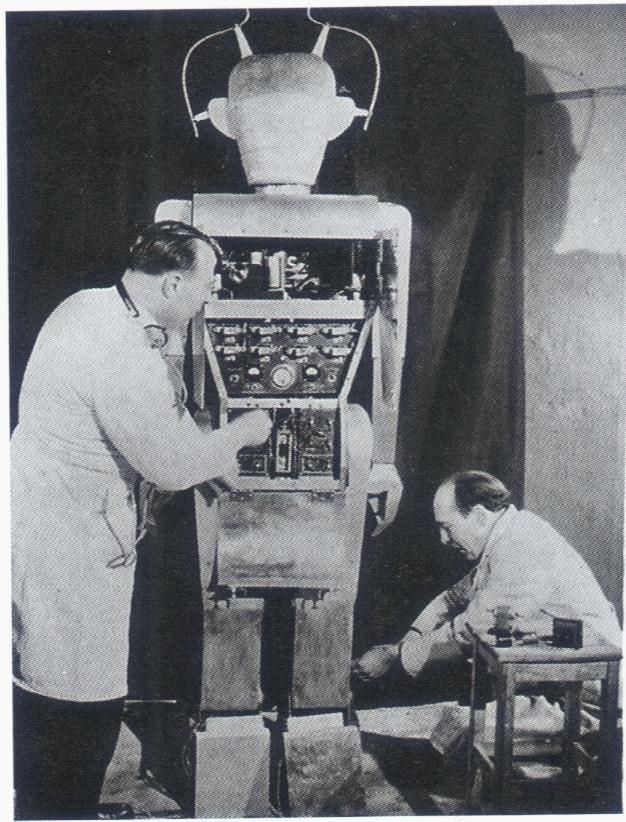
Images are from DRK archive, but are the same as those used in Mechanix Illustrated magazine of April 1948. Inventor is said to be M. Koralek, a noted French engineer.
See other early Humanoid Robots here.
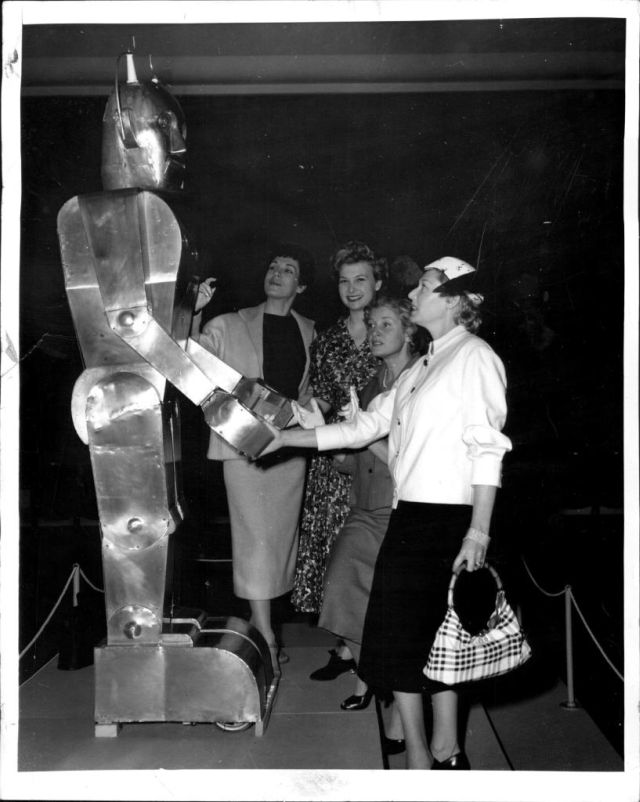
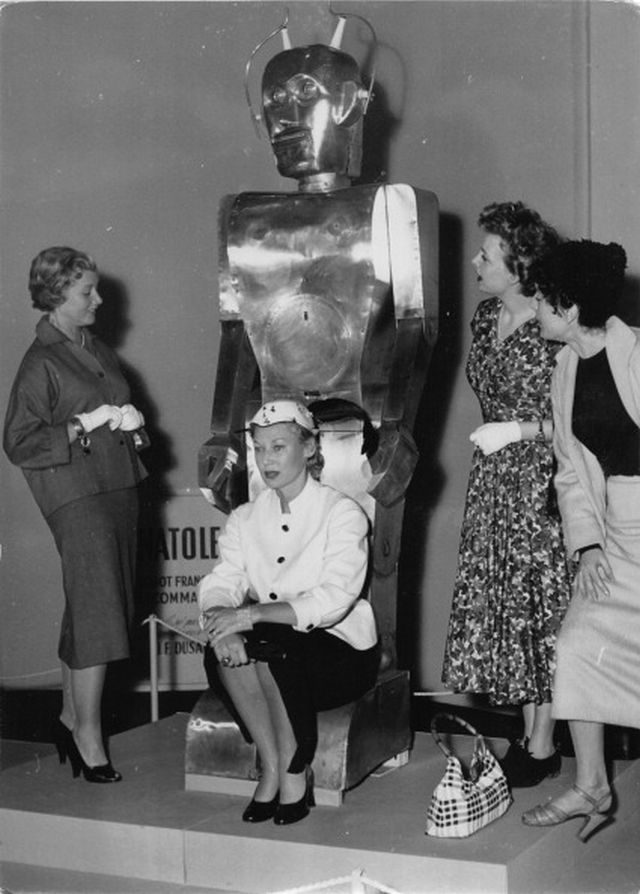
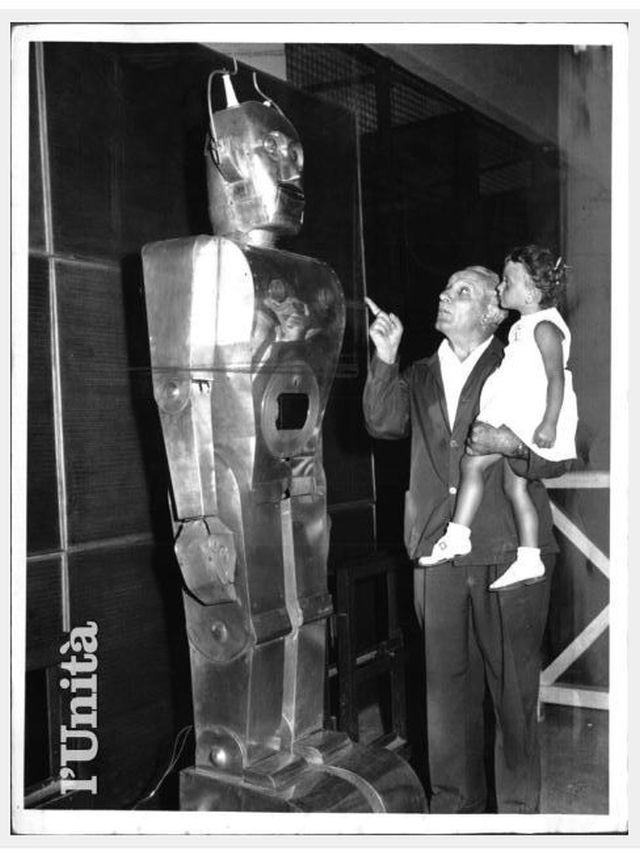

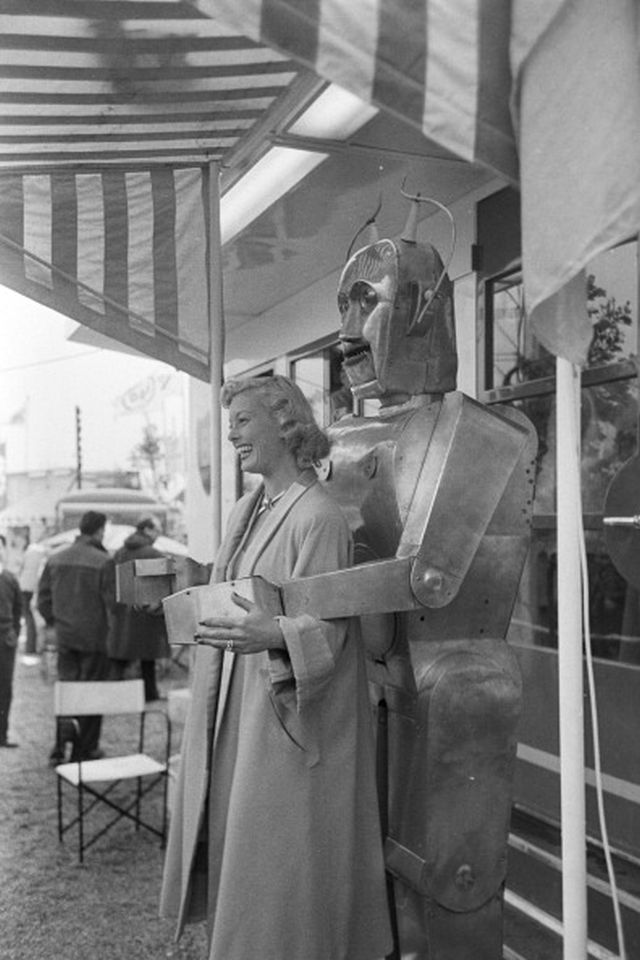
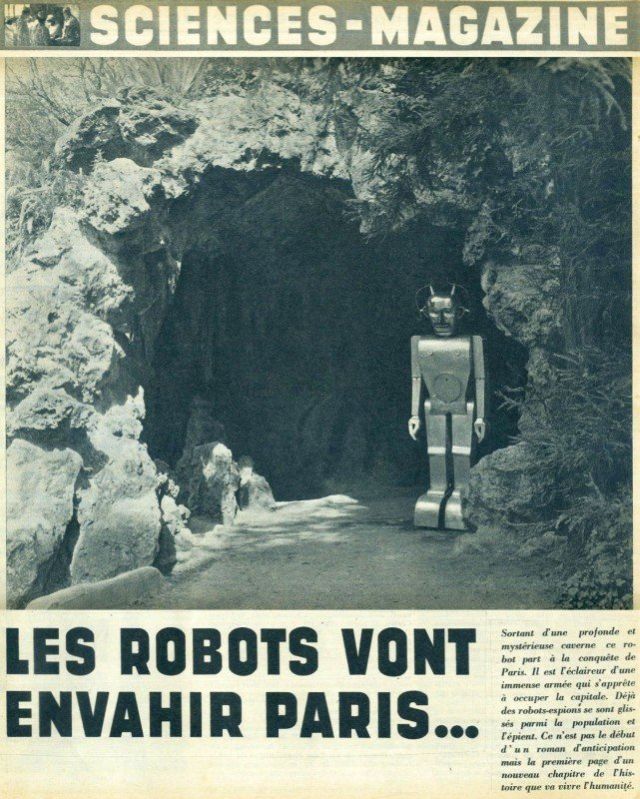
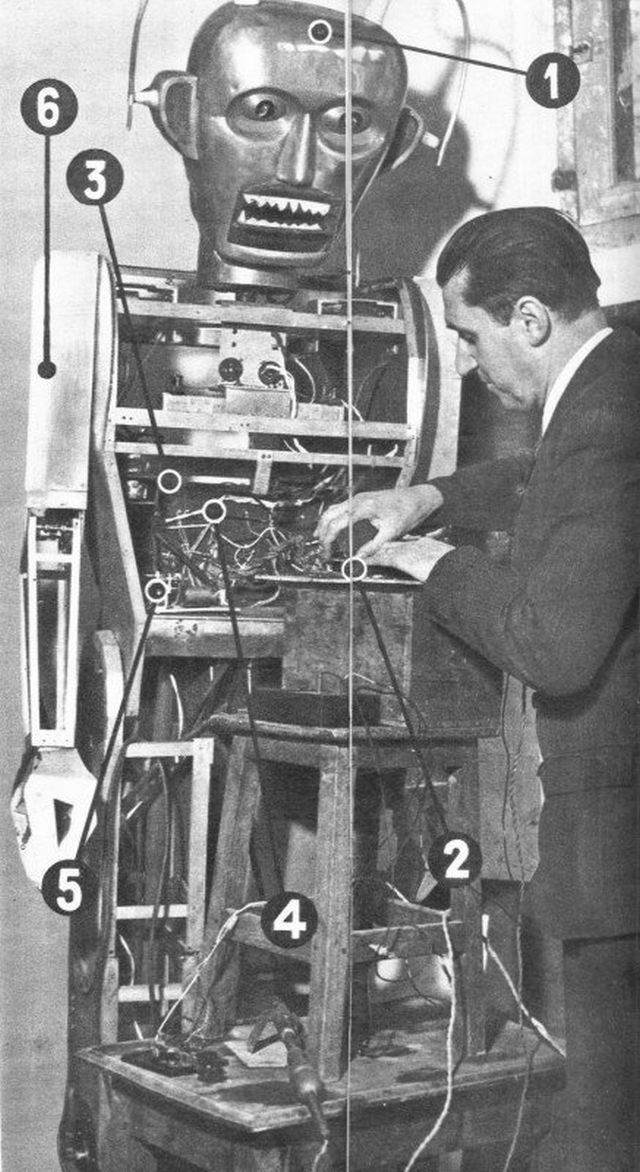
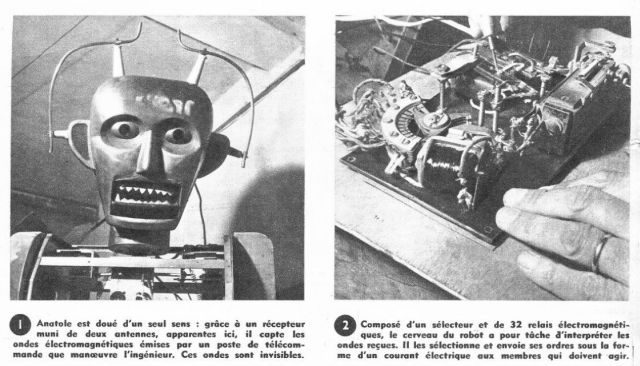
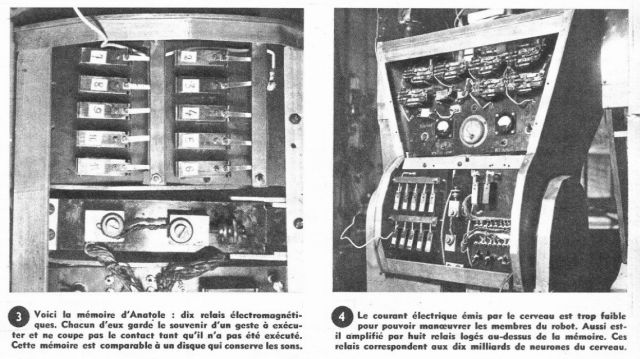
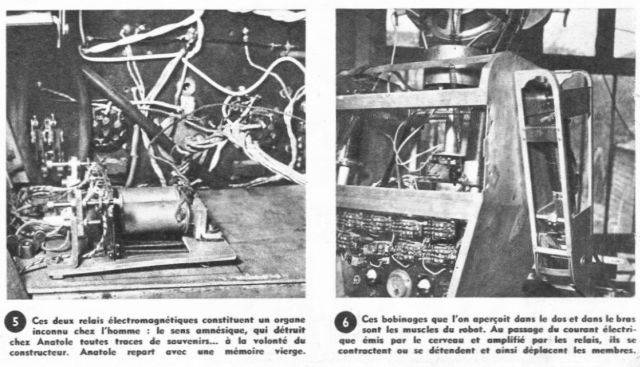
Bonjour, je cherche à joindre Me Christine Luce Merci pour votre aide Cdt M.Dusailly Olivier